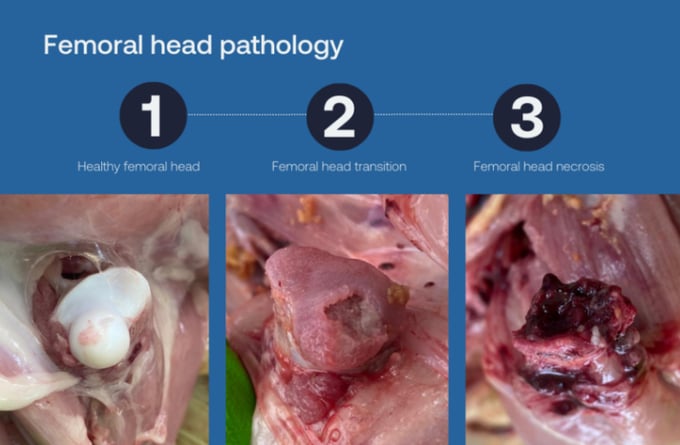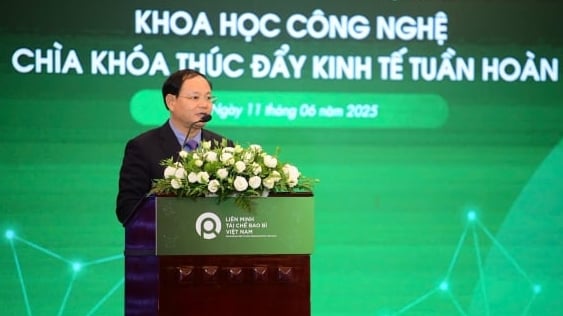June 14, 2025 | 14:19 GMT +7
June 14, 2025 | 14:19 GMT +7
Hotline: 0913.378.918
June 14, 2025 | 14:19 GMT +7
Hotline: 0913.378.918

BCO is often aggravated by secondary factors, such as rickets, caused by imbalances in calcium, phosphorus, or vitamin D levels.
Non-infectious lameness includes conditions like dyschondroplasia (abnormal bone growth), rickets (weak bones due to calcium or vitamin D deficiencies), fractures, and poor nutrition (e.g., lack of choline or biotin). Infectious lameness, on the other hand, is caused by microorganisms like bacteria, but not only and this makes it a very difficult problem to tackle.
One major type of infectious lameness is Bacterial Chondronecrosis with Osteomyelitis (BCO)—a complex condition that stands out as the leading cause of lameness in broilers globally.
BCO is a bacterial infection that affects the bones and joints, particularly those under mechanical stress, such as the femur, tibia, and thoracic vertebrae. These areas are most vulnerable in fast-growing broilers, especially young birds with fragile skeletons.
BCO is widespread, impacting about 1 in every 67 broilers over 30 days of age under normal circumstances. During outbreaks, over 15% of a flock may be affected. In Europe, up to 30% of broilers suffer from painful leg disorders caused by BCO and related skeletal issues, creating both welfare and economic challenges.
BCO is often aggravated by secondary factors, such as rickets, caused by imbalances in calcium, phosphorus, or vitamin D levels. Poor nutrition, chronic gut inflammation, and the destruction of fat-soluble vitamins increase susceptibility. These factors weaken bone development and create ideal conditions for bacterial invasion.
The bacteria responsible for BCO, such as Enterococcus spp., Escherichia coli, and Staphylococcus spp., originate in the gut.
In fast-growing broilers, mechanical stress on bones leads to cartilage damage and inflammation. Damaged areas attract bacteria, which travel from the gut into the bloodstream and settle in joints, multiplying and causing infection.
Young birds are particularly vulnerable because their microbiome is still not established. An immature microbiome and an immature gut tissue makes it easier for harmful bacteria to colonise and consequently transfer into the blood stream.
In some cases, bacteria may also be transmitted vertically from parent stock to chicks.
Treating BCO is difficult, every practitioner can confirm that, and it is due to several factors:
Limited blood flow to cartilage: Bone cartilage has minimal blood supply, making it hard for antibiotics to reach infected areas effectively. Disruption of gut microbiome by antibiotics: While antibiotics can kill harmful bacteria, they also disrupt the gut’s natural balance, delaying the development of beneficial bacteria and leaving room for pathogens to take over. Rapid growth and immature microbiomes: The quick growth of broilers lead to mechanical stress on bones and joints. Simultaneously, their immature intestinal tract and microbiomes heighten their vulnerability to bacterial infections.
The best approach to combat BCO is prevention, focusing on reducing bacterial load, stabilising the gut microbiome, improving intestinal health, and supporting bone and cartilage health. If we really want to have success in preventing BCO, the focus has to be on all of this points.
By implementing these strategies, broiler farmers can significantly reduce the prevalence of BCO, improve bird welfare, and enhance overall productivity. Better gut health and the wright vitamin D supply leads to stronger cartilage and bones, fewer microfractures, and less bacterial spread—ultimately resulting in healthier chickens and fewer cases of BCO.
(Poultryworld)

(VAN) The Department of Agriculture in South Africa has announced the country’s first mass vaccination of poultry to prevent local birds from contracting avian influenza.

(VAN) Establishment of the Mekong Delta Regional Agricultural Linkage Center, aiming for a closed value chain, deep processing, trading platforms, and international market connectivity.

(VAN) Gia Lai province has recently recorded 460 rare species of animals and plants, contributing to forest conservation and biodiversity planning in the region.

(VAN) Ms. Caroline Beresford, New Zealand Ambassador to Vietnam, expressed confidence that agricultural cooperation between Vietnam and New Zealand will develop sustainably, be climate-resilient, and promote gender equality.

(VAN) Vietnam reaffirms its commitment to international cooperation in fostering sustainable and responsible fisheries while ensuring resilient livelihoods for small-scale fishing communities.

(VAN) More than just a technical solution, science and technology are gradually becoming a cornerstone in Vietnam’s journey toward building a circular economy.

(VAN) The Netherlands is ready to accompany Vietnam in building a green, circular, and sustainable agriculture sector that is resilient to climate change.